
|
Indian Journal of Occupational and Environmental Medicine
Medknow Publications
ISSN: 0973-2284 EISSN: 1998-3670
Vol. 10, Num. 2, 2006, pp. 51-52
|
Indian Journal of Occupational and Environmental Medicine, Vol. 10, No. 2, May-August, 2006, pp. 51-52
Editorial
Occupational diseases and disorders: How relevant are they in clinical practice?
Kulkarni GK
General Manager-Medical and OHS, Siemens Ltd. Kalwa Works, Thane Belapur Road, Thane - 400 601, India
Correspondence Address:General Manager-Medical and OHS, Siemens Ltd. Kalwa Works, Thane Belapur Road, Thane - 400 601 Email:
ganesh.kulkarni@siemens.com
Code Number: oe06010
Although most clinicians have a somewhat vague idea of Occupational Medicine as a subset of Preventive Medicine, yet they are mostly not aware of occupational diseases and disorders that can mimic many clinical conditions. Most of such conditions can pose diagnostic difficulties for a pure clinician. In this perspective, let us salute Bernardino Ramazzini, father of Occupational Medicine, who added the most pertinent enquiry in medical history -What is your occupation?- which surprised most of the physicians of that time. Bernardino Ramazzini wanted physicians of that time to appreciate what he had said with conviction - that occupation is associated with certain types of disease manifestations. It has taken us centuries to understand the implications of work environment and disease and their clinical importance.
This has its roots in the following factors: Medical education is more on the curative side; there is glamour due to societal outlook towards practicing physicians; and economic considerations. This has led to the question Healthy man, whose concern?' It is here that the understanding of the practice of Occupational Health by clinicians has a major role to play. Occupational diseases, rehabilitation and problems of placement of people with disabilities have not received the same attention from clinicians as non-occupational problems. Although clinical problems are often too simple for the treating physician, for the patient's workplace requirements, psychological factors and interpersonal relationships can magnify them to major proportions. For these reasons, occupational clinical conditions can prove to be difficult and even burdensome; however, they provide the conscientious physician with one of the finest challenges of medicine, namely, the opportunity to influence an individual's adjustment, rehabilitation or longevity, given his/her working conditions.
Occupational diseases are caused by a pathologic adaptation of the patient to his working environment; hence it is necessary for physicians to evaluate both the patient and environmental exposures. Very few occupational diseases present with specific pathognomic clinical or laboratory findings. Thus anemia of benzene intoxication or lead poisoning, peripheral neuritis of lead or acryl amide poisoning, bronchitis of Byssinosis, the fibrosis of asbestosis, the granuloma of berylliosis and the nodulation of silicosis cannot be diagnosed as to etiologic agents from clinical and laboratory findings alone. Only with the knowledge of exposure, in addition to clinical factors, can an accurate diagnosis be made.
If one looks at the data of the estimate of burden of occupational disease (1.83 million) and occupational injury (18.3 million) in India, the figures indicate that as a nation, India is contributing nearly 20% of the global burden in respective areas. Prevalence studies on occupational disease in many parts of the world have shown such burden to vary from 5 to 20%. So in the Indian context, clinicians should expect on lower fence 5% and upper fence 20% of cases could have occupational cause, depending upon where they practice clinical medicine. It is our observation that highly industrialized belts and localities have high prevalence of occupational diseases and injury.
Clinical medicine as a basic competency is required to be a successful occupational health specialist. This is true because the process of diagnosing an occupational aliment involves the following steps:
- History and physical examination.
- Occupational history and high degree of suspicion.
- Cause-effect relationship.
- Clinical examination.
- Tests for general assessment of health.
- Nonspecific tests for exposure.
- Specific tests that indicate exposure.
- Tests for genetic or acquired susceptibility.
- Biological monitoring.
- Industrial hygiene data.
If one ignores clinical examination, one can miss the diagnosis of occupational illness, as in occupations involving lead: Grayish pigmentation of the gums, intestinal colic, anemia, lead encephalopathy, toxic additive effects on kidney. Occupational asthma can be misinterpreted as bronchial asthma, occupational dermatitis, occupational cancer, occupational lung diseases; occupational cataract and chemical conjunctivitis can all be misdiagnosed as common clinical entities. Burns, musculoskeletal disorders, noise-induced hearing loss, occupational stress and burnout are occupation-related morbidities that can be missed by any physician whose competency in clinical medicine is not sound. Industrial hygiene studies and biological monitoring are special technologies that are not a part of routine clinical medicine practice. Another important area is patient's health data records; these have to be maintained for a long period of time for establishing cause-effect relationship in any occupational health setup. Solvent exposures can manifest in less than a minute, while occupational cancers can come after decades. The list of chemical exposures to substances like mercury, chromium, arsenic, manganese and phosphorus that can simulate a clinical illness is never-ending. In my humble opinion, every clinical medicine specialist can be a super specialist in some or the other areas of Occupational Medicine. Multispecialty skills and competencies are requirements for the practice of Occupational Medicine, which can be built on a solid foundation of clinical medicine.
Occupational diseases and disorders - how relevant are they in clinical practice? The answer of course is, 'Yes, they are very relevant at all levels of clinical practice.' In Occupational Health practice, the teamwork makes everything possible - even the impossible! This article, I am sure, will attract attention from a large number of clinical medicine specialists; it also is a reminder to my Occupational Health colleagues/specialists, how essential it is to be a good clinician if one wants to be a competent Occupational Health specialist.
Copyright 2006 - Indian Journal of Occupational and Environmental Medicine
|
